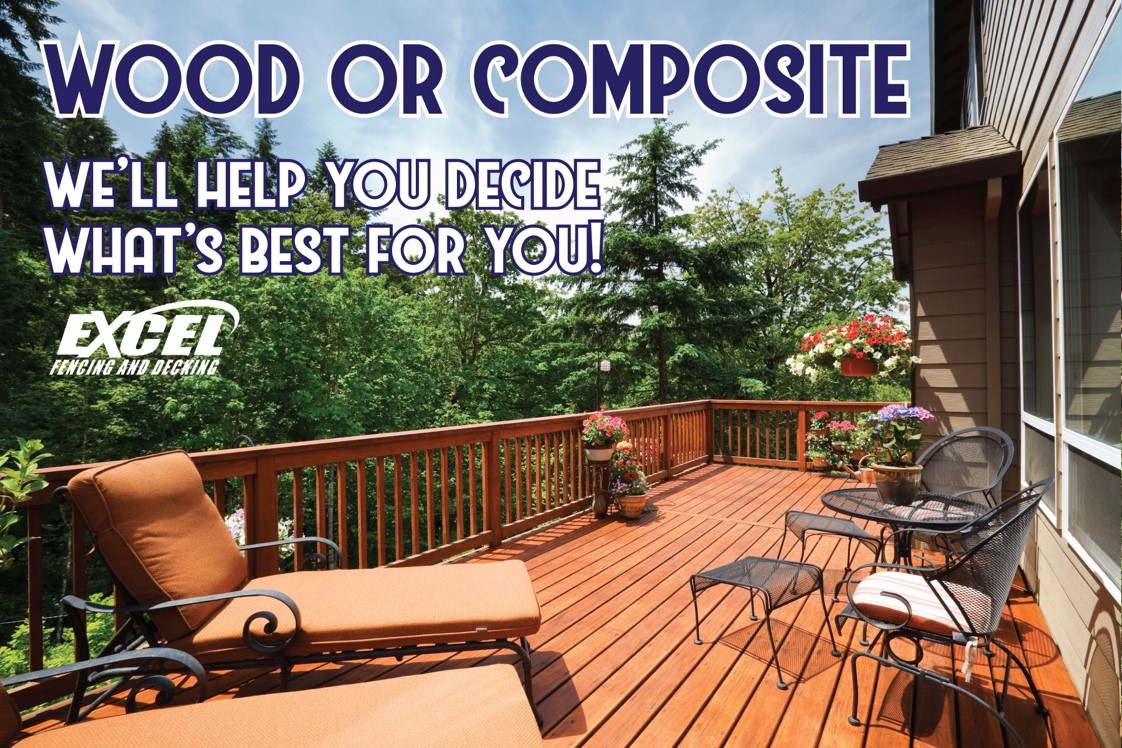
Deck Material:
Composite Deck vs Wood
When the time comes to update your deck or build a new one you are going to need to make a decision about what deck material to use, composite deck vs wood. Both materials can result in a beautiful deck, but there are a lot of points to consider when it comes to your deck budget, your deck maintenance requirements, and how you want to enjoy it.
Wood Deck Material
There are a number of wood options out there, but they not the same at all. Wood is a popular option for its affordability and its natural warm look and feel. One of the most common wood options selected is pressure treated lumber, or PT wood. Pressure treated wood is soaked in insecticides and fungicides which help prevent it from both insect infestation and rot. Even though it has a brown-green color to it off the rack it can still be stained or painted any color you want! Untreated woods that have longevity include Cedar and Redwood. They are stronger than the woods used to make pressure treated wood, and as such they actually tend to last longer. But the top of the line wood products are imported woods like mahogany or ipe. Each natural wood, and treated, have their own color and tone, so your wood selection is also key in personalizing the look of your deck.
A great challenge faced by wood deck owners is weathering and mold. Typically, a deck should be refinished every two or three years, and also should be cleaned once a year. Aging wood can dry out, splinter, and crack; those types of damages may require sanding or even replacement as they crop up. Wood is almost always going to be more affordable than composite, but proper annual maintenance does add up, and it may even make wood a more expensive option in the long run. However, choosing a high-end wood, such as Cedar, Redwood, or even Mahogany or Ipe will lead to a long-lasting deck.
Composite Deck Material
Trex and TimberTech are common names in the composite wood deck material world. Composite wood is made up of a variety of materials including wood scrap, sawdust, recycled plastic, and usually polypropylene. Composite wood is manufactured and is designed to look like real wood, but it has enough of the properties of its plastic components to make it more durable and long-lasting. It cannot be painted, but it can be purchased in a wide variety of colors.
Many people tend to think of composite decking as “no-maintenance” because it is very rarely tended to after installation, but in reality, it is more “low-maintenance.” There is no need to sand, stain, repaint or refinish a composite deck, so that is where the “no-maintenance” portion comes in. However, it can be prone to mold growth. In fact, just about any material that doesn’t have a natural fungicide will facilitate mold growth, especially if it has nooks and crannies for the mold to talk hold. Maintenance is relatively easy though and typically consists of power-washing or soft-washing every couple of years or so.
From a cost standpoint, composite wood deck materials can cost twice as much as their wood counterparts, which can make it a significant deterrent. But on the positive side, the manufacturing process of composite decking is actually very green, and they are made from many recycled materials. This helps to reduce the amount of wood consumption, reduce the amount of scrap sent to the landfill, and reduce how often people need to add new construction onto their homes. Modern composite manufacturing is also very advanced compared to years past and takes advantage of a number of environmentally friendly approaches to the process. Modern composites have also made advances that make it superior to its older counterparts.
